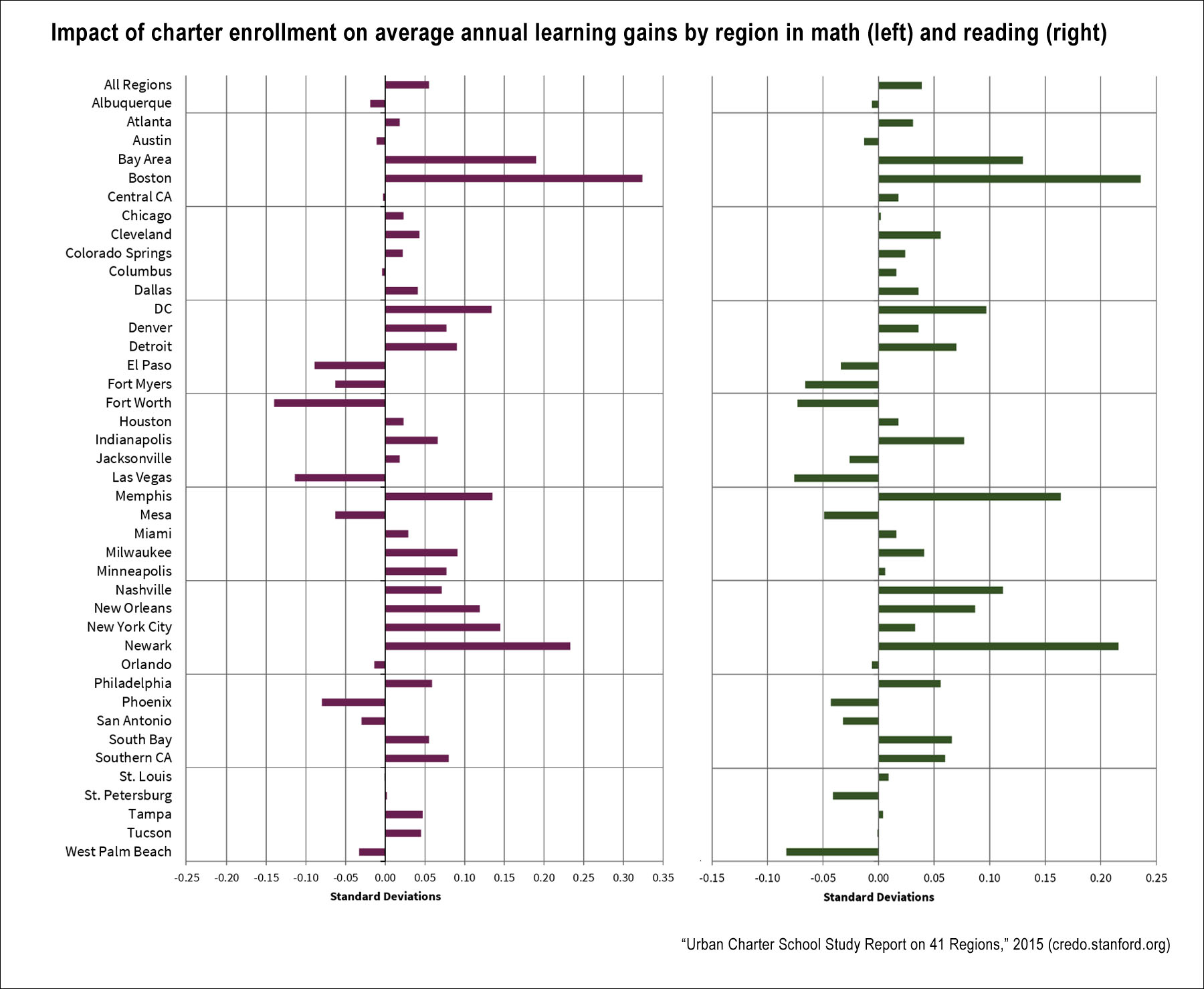As of 2014 there were approximately 6,400 charter schools in the United States serving more than 2.5 million children, according to the National Alliance for Public Charter Schools. The growth of charter schools has been controversial, and scholarship over the past decade has been mixed on their ability to improve outcomes for students who might otherwise be compelled to enter lower-performing schools. Evidence does suggest that charter schools may be more important and relatively effective in urban areas. Still, researchers are just getting to the point where they can assemble sufficiently large datasets to draw more general conclusions about the impact of charter schools.
A 2015 study from Stanford University’s Center for Research on Education Outcomes (CREDO), “Urban Charter School Study: Report on 41 Regions,” examines the direct contribution of charter schools in raising student test scores over a given year — what scholars call the measurable “value added” in student growth — in 41 regions of 22 states. The researchers partnered with the states’ education departments to analyze some 1 million records for charter students and a matched group of comparison traditional public school students over the period 2006 to 2012.
Research findings include:
- Urban charter school students showed “significantly higher levels of annual growth in both math and reading compared to their [traditional public schools] peers…. These results translate to urban charter students receiving the equivalent of roughly 40 days of additional learning per year in math and 28 additional days of learning per year in reading.”
- While the overall picture bolsters the case for charter schools, there is significant regional variation: 26 urban areas saw gains in math among charter school students, while 11 saw relative declines; 23 areas saw gains in reading, while 10 saw no such improvements. Eight urban areas among the 41 saw little difference between charter school and traditional public schools for students.
- Among the urban areas that saw notably positive results among charter school students, Boston, Newark, Memphis and Washington, D.C., were standouts. Comparatively negative outcomes were found for cities in Florida, Texas and the Southwest.
- Gains are particularly noteworthy among Black, Hispanic (and English-language learners) and special-education children: “Gains for these subpopulations amount to months of additional learning per year.” However, “These results are partially offset … by the negative impact on math and reading growth experienced by white students enrolled in urban charter schools and for Native American students in math.”
- “Across all urban regions, black students in poverty receive the equivalent of 59 days of additional learning in math and 44 days of additional learning in reading compared to their peers in [traditional public schools]. Hispanic students in poverty experience the equivalent of 48 days of additional learning in math and 25 days of additional learning in reading in charter schools relative to their peers in [traditional public schools].”
- “Despite the overall positive learning impacts, there are urban communities in which the majority of the charter schools lag the learning gains of their [traditional public schools] counterparts, some to distressingly large degrees. In some urban areas, cities have no schools that post better gains than their [traditional public school] alternatives and more than half the schools are significantly worse.”
The analysis is the third major study issued by the Stanford research group, which also published widely discussed — and somewhat controversial — findings in both 2009 and 2013. The researchers have stated that no one study will be definitive, but the accumulated evidence makes a stronger case over time. Observers of the 2015 findings note two important points: First, the 2015 report has fairly different conclusions than reports from prior years, suggesting no obvious bias; Second, although this wide-view level analysis is important, it is not quite as valid as some of the research done on charters based on admissions lotteries (which focus on a relatively small sample of charters). Analyzing districts where there are randomized lotteries helps rule out research confounding issues, as populations with certain characteristics may be predisposed to selecting in or out of charter schools.
Below are detailed breakouts of the study’s results according to urban area (see more here on the meaning of the statistical term “standard deviation”):

Keywords: African-American, Hispanic, Latino, charter schools, children, youth


Expert Commentary